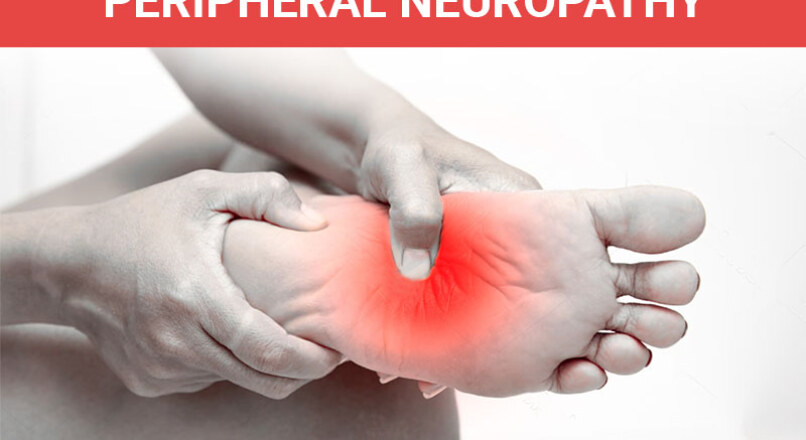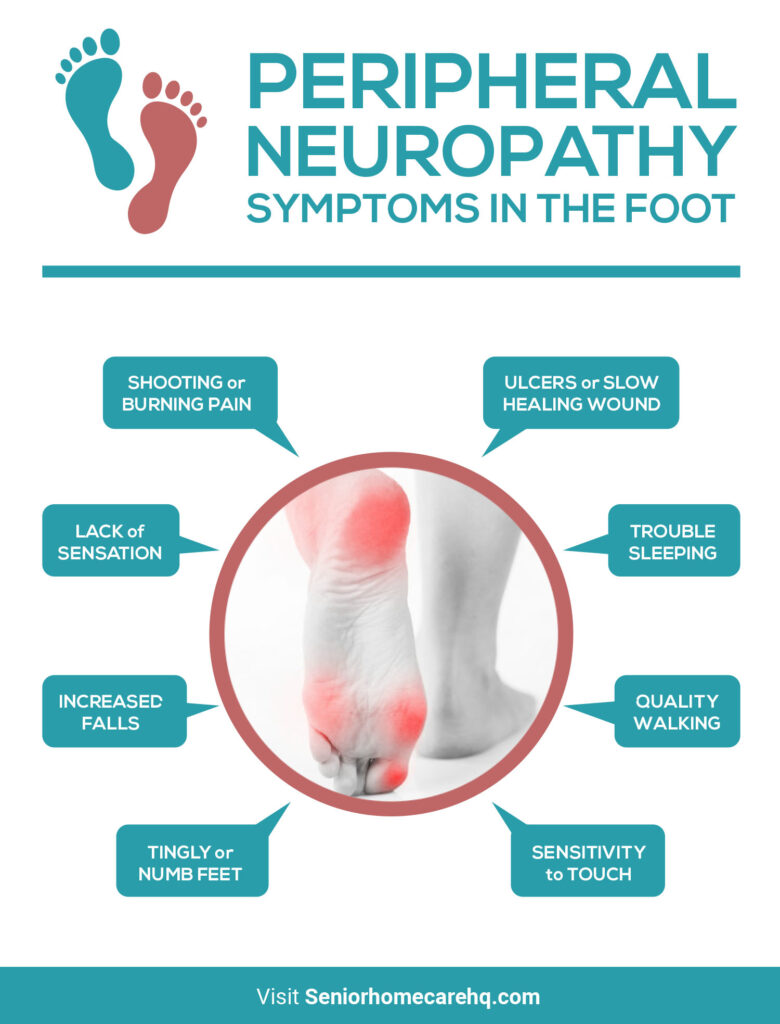
The Best Way To Manage Diabetic Peripheral Neuropathy in the Legs and Feet As An Elderly Senior Living at Home.
[su_highlight]Seniors Managing Diabetic Peripheral Neuropathy in the Legs and Feet While at Home.[/su_highlight]
Peripheral neuropathy symptoms can range from a mild inconvenience to a serious medical condition that requires great amounts of attention and care.
Seniors living with peripheral neuropathy can still perform daily activities but may need some lifestyle changes and adaptations.
We are going to review peripheral neuropathy as a diagnosis and discuss modification options for seniors to maintain functional performance at home.
[su_highlight]What Is Peripheral Neuropathy?[/su_highlight]
Peripheral neuropathy is actually an umbrella term that describes multiple medical conditions that negatively impact or damage the peripheral nervous system.
To minimize confusion, let’s clarify that the body is made up of the central nervous system (brain and spinal cord) and the peripheral nervous system (the rest of the body).
The central nervous has a two-way communication with the peripheral nervous system. For example, if your foot hurts that signals to the brain that your foot is in pain which causes a reaction (“Ouch”).
There are over 100 types of peripheral neuropathy, ranging from mild to severe symptoms such as loss of sensation and impaired movement. The most common form of peripheral neuropathy is linked to diabetes (NINDS Institute, 2021).
High glucose levels cause damage to peripheral nerves over time resulting in a multitude of problems in the limbs: numbness, tingling, stabbing pain, weakness, discoloration, inaccurate temperature perception, trouble with balance and walking, etc.

[su_highlight]How Is Peripheral Neuropathy Treated? [/su_highlight]
There is no cure for diabetic peripheral neuropathy, so what is left is managing the symptoms.
Options include better managing diabetes, changing diet, increasing exercise, prescribing nerve pain medications, and managing complications (high blood pressure, infections, digestive issues).
[su_highlight]Best Way to Perform ADLs at Home if You Have Peripheral Neuropathy in Your Legs and Feet.[/su_highlight]
Seniors living with diabetic peripheral neuropathy can still complete activities of daily living (ADLs) at home with as much independence as possible.
Use lifestyle modifications that limit the following: unnecessary pain and possible skin damage.
- Wear comfortable shoes and socks everywhere you go. Make sure that you avoid footwear that cuts or rubs the feet the wrong way to prevent possible sores.
- Use a cane or a walker if your neuropathy is compromising your balance.
- Frequently elevate your feet and take sitting breaks to regenerate the blood circulation through your feet.
- Stay updated on pain medication and skin checks to minimize soreness while completing ADLs.
- Ask for help when needed. You do not have to do everything in one day, and you certainly don’t have to do it all on your own.
- Make your best efforts to keep an uncluttered living space. This will help prevent tripping hazards that you may not feel coming and reduce the risk for injuring your feet.
[su_highlight]Things to Avoid or Preventative Tips While Performing Functional Activities of Daily Living.[/su_highlight]
One of the key concerns for seniors with peripheral neuropathy is protecting the feet. Neuropathy caused by uncontrolled diabetes results in decreased sensation and a reduced ability to heal.
This makes individuals very susceptible to foot wounds (diabetic ulcers) that can get infected due to a weakened immune system.
Seniors living with peripheral neuropathy in their feet need to do everything to protect the feet from damage.
This includes wearing comfortable socks with sturdy shoes, avoiding dropping items on the toes, watching wear you step to avoid stubbing toes and cracking toenails, etc. Seniors should also improve their foot hygiene habits.
Keep the skin clean, brush the feet generously with every shower or bath, regularly use lotions to prevent drying and cracking, keep the toenails trim, and attend regular podiatry check-ups for common foot infections and minor abrasions.
[su_highlight]Recommended Footwear and Lower Extremity Foot Inspections.[/su_highlight]
When investigating orthotic footwear for peripheral neuropathy, seniors should consider the following:
[su_label type=”success”]Cooling Features:[/su_label] temperature control of the shoe to prevent freezing or sweating.
[su_label type=”success”]Arch Support:[/su_label]Full and complete arch support to prevent unneeded pressure-point pain.
[su_label type=”success”]Sturdy Foot Alignment:[/su_label] A shoe that provides ankle and foot support to keep the foot from overturning or misaligning while walking.
[su_label type=”success”]Soft Cushioned Insole:[/su_label] Look for shoes with plush and supportive fabric to minimize risk for pain and sores.
[su_label type=”success”]Foot Contour:[/su_label] Find an orthotic shoe that contours to your type of foot. This may require getting fitted for custom-made shoes, which is well worth it in severe cases of neuropathy.
[su_label type=”success”]Socks that Best Fit the Shoe:[/su_label] Select the right socks that aren’t too thick or thin, and fit well within the shoe.
Seniors can conduct their own lower extremity inspections at home or with the help of a family member or caregiver. Inspections for peripheral neuropathy of the feet should include:
[su_label type=”success”]Assessing the Skin Color:[/su_label] Look for any strange coloring like increased redness or even blue hues. Redness with inflammation could possibly indicate infection that needs to be inspected by a doctor right away.
[su_label type=”success”]Testing Sensation:[/su_label] Check sense of touch throughout the legs to see if symptoms are improving or worsening.
Sensation tests should include tactile (touch), proprioception (identifying where your limb is in space with your eyes closed), temperature (hot and cold), and pain.
[su_label type=”success”]Investigating Any Skin and Nail Abnormalities:[/su_label] Give attention to every aspect of your lower limb, including heels, toes, and toenails where sores can develop.
Note any skin changes such as scarring, cuts, bruises, minor rashes or abrasions and monitor any additional changes over the next few days. New open wounds or inflamed rashes should be assessed by a doctor immediately.
[su_label type=”success”]Testing For Tissue Swelling and Circulation:[/su_label] Assess your feet for lymphedema and poor circulation. Press one finger into various parts of the feet and legs to see if imprints are left in the skin.
If the skin bounces back, then swelling is minimal. Also check for blanching where you poke various parts of the lower limb and inspect to see if the whiteness left on the skin fills with a pinkish hue.
[su_highlight]Summary[/su_highlight]
Peripheral neuropathy can be a debilitating condition for seniors living at home.
By managing the symptoms, adhering to lifestyle changes, following up with doctors, and practicing safe movement and lower limb inspections, seniors can still function well at home.
References
- Peripheral Neuropathy Fact Sheet (2021). National Institute of Neurological Disorders and Stroke. https://www.ninds.nih.gov/Disorders/Patient-Caregiver-Education/Fact-Sheets/Peripheral-Neuropathy-Fact-Sheet#3208_1

Leave a reply